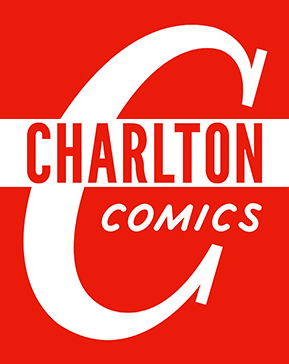
Charlton Comics was an American comic-book publishing company that existed from 1945 to 1986, having begun under a different name: T. W. O. Charles Company, in 1940. It was based in Derby, Connecticut. The comic-book line was a division of Charlton Publications, which published magazines, puzzle books, and briefly, books. It had its own distribution company.
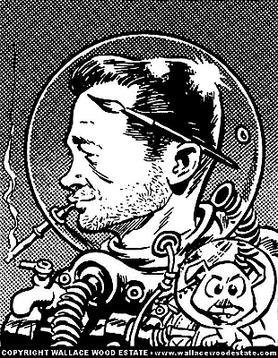
Wallace Allan Wood was an American comic book writer, artist and independent publisher, widely known for his work on EC Comics's titles such as Weird Science, Weird Fantasy, and MAD Magazine from its inception in 1952 until 1964, as well as for T.H.U.N.D.E.R. Agents, and work for Warren Publishing's Creepy. He drew a few early issues of Marvel's Daredevil and established the title character's distinctive red costume. Wood created and owned the long-running characters Sally Forth and Cannon.
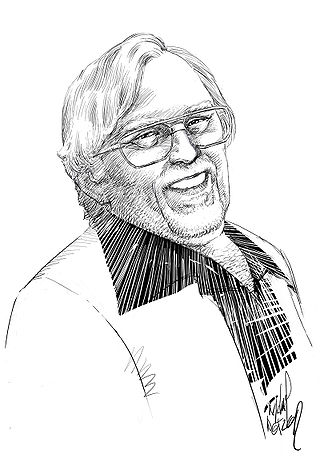
Richard Joseph Giordano was an American comics artist and editor whose career included introducing Charlton Comics' "Action Heroes" stable of superheroes and serving as executive editor of DC Comics.

John Victor Romita was an American comic book artist best known for his work on Marvel Comics' The Amazing Spider-Man and for co-creating characters including Mary Jane Watson, the Punisher, Kingpin, Wolverine, and Luke Cage. Romita was the father of John Romita Jr., also a comic book artist, and the husband of Virginia Romita, who was for many years Marvel's traffic manager.

Fawcett Comics, a division of Fawcett Publications, was one of several successful comic book publishers during the Golden Age of Comic Books in the 1940s. Its most popular character was Captain Marvel, the alter ego of radio reporter Billy Batson, who transformed into the hero whenever he said the magic word "Shazam!".

Vincent Colletta was an American comic book artist and art director best known as one of Jack Kirby's frequent inkers during the 1950s-1960s period called the Silver Age of comic books. This included some significant early issues of Marvel Comics' Fantastic Four, and a long, celebrated run on the character Thor in Journey into Mystery and The Mighty Thor.
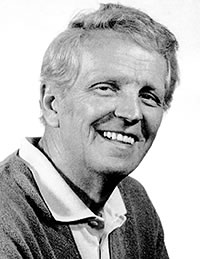
George Tuska, who early in his career used a variety of pen names including Carl Larson, was an American comic book and newspaper comic strip artist best known for his 1940s work on various Captain Marvel titles and the crime fiction series Crime Does Not Pay and for his 1960s work illustrating Iron Man and other Marvel Comics characters. He also drew the DC Comics newspaper comic strip The World's Greatest Superheroes from 1978–1982.

Jack Abel was an American comic book artist best known as an inker for leading publishers DC Comics and Marvel Comics. He was DC's primary inker on the Superman titles in the late 1960s and early 1970s, and inked penciler Herb Trimpe's introduction of the popular superhero Wolverine in The Incredible Hulk #181. He sometimes used the pseudonym Gary Michaels.
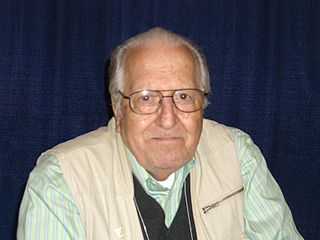
Nicholas Viscardi, known professionally as Nick Cardy and Nick Cardi, was an American comics artist best known for his DC Comics work on Aquaman, the Teen Titans and other major characters. Cardy was inducted into the Will Eisner Comic Book Hall of Fame in 2005.

Fiction House was an American publisher of pulp magazines and comic books that existed from the 1920s to the 1950s. It was founded by John B. "Jack" Kelly and John W. Glenister. By the late 1930s, the publisher was Thurman T. Scott. Its comics division was best known for its pinup-style good girl art, as epitomized by the company's most popular character, Sheena, Queen of the Jungle.
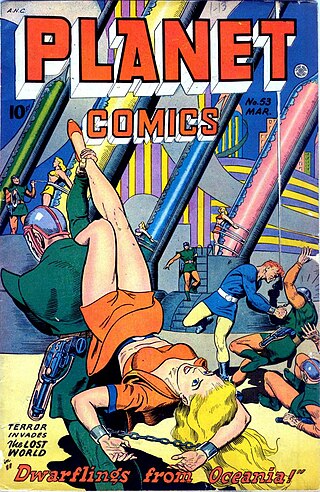
Planet Comics was a science fiction comic book title published by Fiction House from January 1940 to Winter 1953. It was the first comic book dedicated wholly to science fiction. Like most of Fiction House's early comics titles, Planet Comics was a spinoff of a pulp magazine, in this case Planet Stories. Like the magazine before it, Planet Comics features space operatic tales of muscular, heroic space adventurers who are quick with their "ray pistols" and always running into gorgeous women who need rescuing from bug-eyed space aliens or fiendish interstellar bad guys.
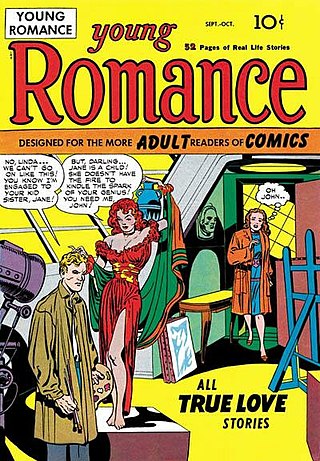
Romance comics are a genre of comic books that were most popular during the Golden Age of Comics. The market for comics, which had been growing rapidly throughout the 1940s, began to plummet after the end of World War II when military contracts to provide disposable reading matter to servicemen ended. This left many comic creators seeking new markets. The romance comic genre was created by Joe Simon and Jack Kirby, who kicked off Young Romance in 1947 in an effort to tap into new adult audiences. In the next 30 years, over 200 issues of the flagship romance comic would be produced.
Girls' Romances is a romance comic anthology published by DC Comics in the United States. Debuting with a Feb.,/Mar. 1950 cover-date, it ran for 160 issues, ending with the Oct. 1971 issue.
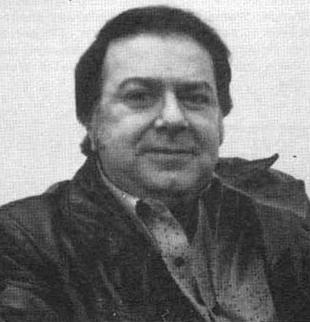
Michael "Mike" Esposito, who sometimes used the pseudonyms Mickey Demeo, Mickey Dee, Michael Dee, and Joe Gaudioso, was an American comic book artist whose work for DC Comics, Marvel Comics and others spanned the 1950s to the 2000s. As a comic book inker teamed with his childhood friend Ross Andru, he drew for such major titles as The Amazing Spider-Man and Wonder Woman. An Andru-Esposito drawing of Wonder Woman appears on a 2006 U.S. stamp.

Young Romance is a romantic comic book series created by Joe Simon and Jack Kirby for the Crestwood Publications imprint Prize Comics in 1947. Generally considered the first romance comic, the series ran for 124 consecutive issues under Prize imprint, and a further 84 published by DC Comics after Crestwood stopped producing comics.

Girl Comics is the name of two comic-book series published by Marvel Comics and its forerunners, Timely Comics and Atlas Comics. The first, debuting in 1949, ran 35 issues, changing its title to Girl Confessions with issue #13. The second was a three-issue limited series published in 2010.
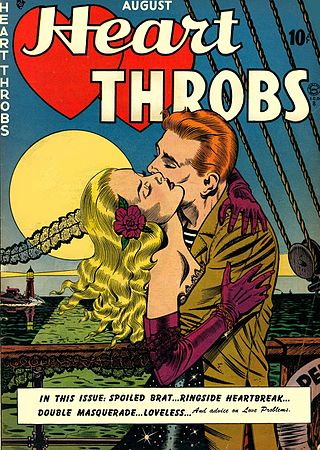
Heart Throbs was a romance comic published by Quality Comics and DC Comics from 1949 to 1972. Quality published the book from 1949–1957, when it was acquired by DC. Most issues featured a number of short comics stories, as well advice columns, text pieces, and filler. The long-running feature "3 Girls—Their Lives—Their Loves", drawn by Jay Scott Pike and inked by Russ Jones, ran in Heart Throbs from 1966–1970.
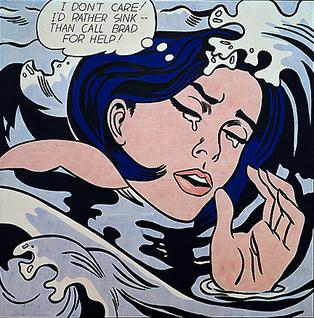
Drowning Girl is a 1963 American painting in oil and synthetic polymer paint on canvas by Roy Lichtenstein, based on original art by Tony Abruzzo. The painting is considered among Lichtenstein's most significant works, perhaps on a par with his acclaimed 1963 diptych Whaam!. One of the most representative paintings of the pop art movement, Drowning Girl was acquired by the Museum of Modern Art in 1971.

Arthur F. Peddy was an American comic book and advertising artist best known for co-creating Quality Comics' superhero character Phantom Lady and Atlas Comics' jungle girl character Jann of the Jungle. He also was known for a stint as penciler of the superhero team the Justice Society of America for what later became DC Comics.
Anthony "Tony" Abruzzo (1916–1990) was an American comic book artist. He is best known for his work in the romance comics field for National Periodicals, particularly Girls' Love Stories, for which he illustrated stories continuously from 1954 to 1972. In the early 1960s, pop artist Roy Lichtenstein derived many of his best-known works from the panels of romance comics that had been illustrated by Abruzzo.
















